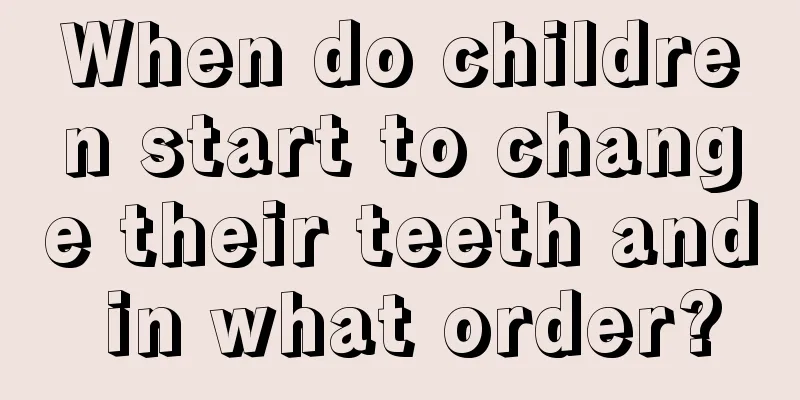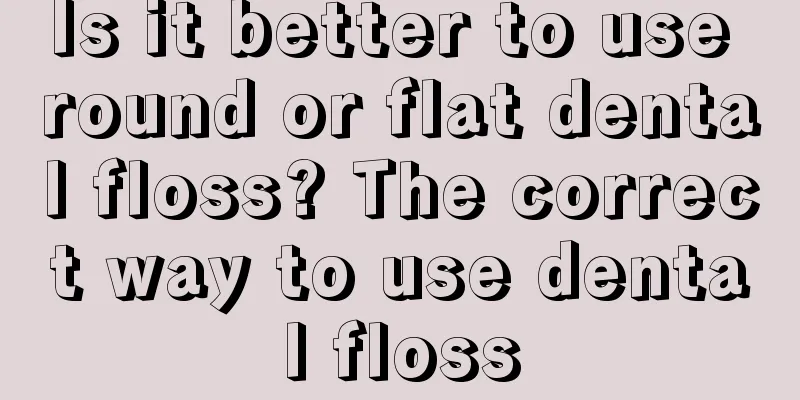When do children start to change their teeth and in what order?

|
Children's oral hygiene should be paid close attention to from an early age. A row of neat and white teeth will leave a good impression on people. So when do children change their teeth? What is the order of children's tooth change? What are the precautions for children's tooth change? What are the causes of children's tooth deformities? What should I do if children's teeth are not aligned? The following editor will introduce you in detail. When do children lose their teeth?Generally speaking, a normal child grows permanent teeth around the age of six. The first tooth does not replace the deciduous tooth, but grows directly from the back of the last deciduous tooth (the fifth tooth). This tooth is the first permanent molar, which is commonly known as the sixth-year molar. After the sixth-year molar erupts completely, the upper teeth 1, 2, 4, 3, 5, 7 and the lower teeth 1, 2, 3, 4, 5, 7 will grow out in the order. Except for the seventh tooth, the other five teeth will replace the deciduous teeth. The order of the eruption of the three teeth 3, 4, and 5 may also be different. If you haven't changed your teeth at the age of 8, it can't be said to be abnormal, because the time for each child to change teeth is different. But under normal circumstances, 70% of children will replace their molars before the age of 8. Then the child will grow upper central incisors and lower lateral incisors at the age of 7-8, upper lateral incisors at the age of 8-9, first and second canines at the age of 9-12, and permanent canines at the age of 10-12. Special attention: If a child loses teeth before the age of 4, it may be caused by internal reasons of the body or local reasons of the oral cavity, such as metabolic disorders or periodontal diseases. We need to know what causes premature loss of deciduous teeth in order to protect the remaining deciduous teeth. If a child has not lost a tooth after the age of 7, he should be taken to the hospital for examination by the oral department. Generally, doctors will take X-rays to check whether the permanent teeth are buried in the gums or have any developmental problems. What is the order in which children's teeth change?Human teeth have two stages: deciduous teeth and permanent teeth. The deciduous teeth stage lasts throughout the infant and childhood stages, while the permanent teeth that replace deciduous teeth can accompany people almost throughout their lives. There are 20 deciduous teeth, which usually begin to erupt around 6 months old and grow fully by 2-3 years old. There are 28-32 permanent teeth (the number of wisdom teeth is 0-4), which usually begin to erupt around 6 years old and grow fully by 12-13 years old (wisdom teeth vary from person to person). Therefore, the tooth replacement period is usually between 6 and 12 years old. There are certain rules for tooth replacement. Simply put, it is "a certain time, a certain order, symmetrical, first down and then up". The symmetrical first down and then up refers to the same-name teeth. The physiological shedding of the first deciduous tooth mostly occurs at around 6 years old, but it can also happen as early as 4 years old, or as late as 7-8 years old. There is no need to worry. The naturally fallen deciduous teeth have no roots, and the shedding surface is eroded. Parents should pay attention to observe and not confuse it with the broken roots of deciduous teeth. There are two different opinions about which permanent tooth a child grows first. One is that the first permanent molar that grows around 6 years old usually grows close to the last deciduous molar, called the sixth-year molar, which erupts earlier or at the same time as the lower central incisor. Another opinion is that the child first replaces the two front teeth in the middle of the lower row. Dentists say that each child may be different. Then, the child grows the upper central incisor and lower lateral incisor when he is 7-8 years old, the upper lateral incisor when he is 8-9 years old, the first and second bicuspids when he is 9-12 years old, and the permanent canines when he is 10-12 years old. Precautions for children's tooth replacement1. Maintain oral hygiene. Oral health is the key You should brush your teeth every morning and evening, and master and use the correct brushing method to thoroughly remove food residues and keep your mouth clean. 2. Strengthen nutrition and cultivate good eating habits Pay attention to the intake of calcium, phosphorus and fluoride in the diet, and provide vegetables and fruits rich in fiber. Do not eat too much sweets and candies, and it is best to eat less sugar cane, especially when the small permanent teeth have just erupted, do not eat sugar cane, and eat less hard food. 3. Discover and correct bad habits early Such as sucking fingers, sticking out tongue, licking teeth, biting pencils, chewing on one side, biting lips, etc. 4. Regular check-ups and early treatment of diseases If caries is found, it should be treated early. If the deciduous teeth have not fallen out and the corresponding permanent teeth have erupted, the deciduous teeth should be extracted early. If an extra tooth grows between two normal teeth, it should be extracted in time. Causes of dental deformities in childrenThe causes of children's dental deformities can be roughly divided into two categories: genetic factors and environmental factors. According to clinical statistics, genetic factors account for 29% of the causes of malocclusion, and environmental factors account for 71%. Among environmental factors, acquired factors play a great role, among which the degeneration of chewing function is one of the main reasons. In the process of human evolution, food changes from raw to cooked, from coarse to fine, and from hard to soft, and the function of the chewing organ is weakened day by day. The degeneration and reduction of the chewing organ lead to an imbalance, that is, the muscles come first, followed by the jaws, and then the teeth. The jaws are reduced but the number of teeth has not decreased, so the jaws cannot accommodate all the teeth, resulting in deformities such as crowded teeth. If a child is found to have uneven teeth after the replacement of teeth, parents should pay attention to it. At this time, they should choose braces suitable for children to correct the uneven teeth of children in time. What to do if children have uneven teeth1. Fixed brace: the most commonly used brace. But you cannot put it on or take it off by yourself. 2. Functional orthodontic appliances: They are mainly used for children who are in the period of tooth replacement or have just replaced their teeth and are still in the peak period of growth and development. Functional orthodontic appliances can correct bone malocclusions and deformities. 3. Removable braces: They are generally used to correct simple malocclusions and deformities during the deciduous and replacement dentition periods, or can be used in conjunction with fixed braces for correction. They can be put on and removed by the user. 4. Orthognathic surgery: When severe dentofacial deformities, such as maxillary protrusion, maxillary retrognathic, mandibular protrusion, and mandibular retrognathic, cannot be solved by simple correction, a combined correction method of surgery and orthodontics is required. |
Recommend
Can pregnant women eat Wutacai? Who should eat Wutacai?
Wutacai is actually a green vegetable, but there ...
Can I take medicine if I catch a cold during the pregnancy preparation period? Will a cold during the pregnancy preparation period affect pregnancy?
There is a tragedy called catching a cold when pr...
How to wean your baby? Five things to note when weaning your baby
When the baby grows to a certain stage, it is nec...
What does a chest X-ray mainly check? How long after a chest X-ray can men and women have children?
Chest X-ray mainly uses X-rays to see if there ar...
Can babies eat shepherd's purse? Can a one-year-old child eat shepherd's purse?
As one of the spring delicacies, shepherd's p...
How to manage baby's toys and how to clean them
Babies cannot grow without toys, and the most ann...
Do Kao diapers have a diaper-protecting factor? Is it normal for Kao diapers to have a grainy feel?
Kao's products are quite good except for the ...
How to avoid dystocia and reduce the incidence
Giving birth to a new life always brings joy, but...
What are the benefits of natural childbirth for mothers?
There are many benefits of natural childbirth, su...
How to teach children to obey traffic rules
The number of deaths in car accidents is increasi...
What medicine should pregnant women take for diarrhea? How to prevent diarrhea in pregnant women?
Pregnant women must pay more attention to their p...
What are the common problems of baby tooth decay? What should be paid attention to in tooth decay problems?
Dental caries, also known as tooth decay, is a co...
Can newborns with nasal congestion drink ginger water? Generally not recommended
Nasal congestion is a common phenomenon. So, can ...
Can I still get pregnant if I have ovulation bleeding?
When it comes to ovulation bleeding, everyone may...
Is Shuke toothpaste a Chinese product? How is Shuke toothpaste?
Toothpaste is used every day, and every time you ...









